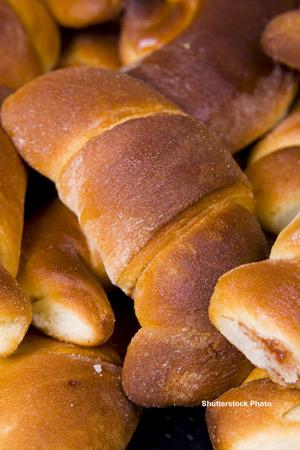
My grandfather passed away when I was nine years old. Though certain memories of him run the risk of losing clarity, others are snapshots in the back of my mind. I can see him eating handfuls of peanuts while he watching football games with my father. I can recall his white cotton shirts and the softness of his skin. I remember the stories he told me while I sat on his lap as a young girl. I can still see his remarkable grey eyes that held wisdom and wonder. A man of gentle strength, my grandfather left behind a family heirloom that will forever keep him alive in my heart.
Faded and worn, on a thinning piece of paper, is my grandfather’s recipe for buttermilk rolls. Written in delicate loops of cursive, it lists every measurement and preparation, from how the dough must rise to baking the bread just enough to give it a crisp, golden brown edge. I still remember the rolls, served in a paper-lined basket or resting on a plate filled with collard greens and fried chicken. I remember the taste. Before my grandfather’s passing, his rolls were a staple at all Thanksgiving and Christmas gatherings. Light as air. Sweet as heaven.
African-American families know the virtue of preparing a meal with love and care. Beyond the enticing aromas, and comforting presentation that goes into setting the family table, there is the grace of tradition. My grandfather deeply believed in tradition.
In the years that followed grandfather’s passing, my family began a new tradition that has held strong to this day. We all received a copy of the cherished recipe. We made an agreement to use a recipe to try to create the closest version possible of grandfather’s rolls. My uncle Walter became the “bread winner” of the re-creations. They did not quite capture the complete essence my grandfather creations, but they were a close match. Sweet, tender, and leaving your taste buds pleading for more. It was a humble start.
As I reached my early 20s, I developed a knack for cooking. I believed I was ready to take my turn to make grandfather’s rolls myself. My first attempt, however, was a deeply felt frustration. I followed the recipe word for word. I felt as if my grandfather was right there with me, watching me turn the dough and set it to rise. Something was missing; there was not quite the right amount of sweetness. There was not quite the right amount of sweetness. Maybe the yeast had not set long enough?
I brought my rolls to the family dinner regardless. My family praised me for trying, claiming they were not far from the real thing. However, I am sure their encouragement was a bit overzealous, although it was appreciated. The entire family agreed that no one could duplicate Grandpa’s recipe. We had all come to the same conclusion; despite our best efforts, it might be possible that grandfather may have omitted an ingredient or two in his written recipe. On purpose?
The best chefs never give away their culinary secrets. If my grandfather left a secret ingredient out of his written recipe, I do not believe it was to remain the sole champion of a family favorite. I do believe — knowing his love of family and the value of tradition — that it was his way of making sure that, when the day came that he could no longer sit down with us at the family table, he would somehow be present. I believe that every time we try to perfect his rolls, we are holding on to his memory and becoming closer as a family. A bond defines our family’s pride, patience, and preservation. When it came to my grandfather, it truly was all about family.
Grandfather James McCreary’s Buttermilk Rolls
2 packages of yeast
½ cup warm water to which 1 teaspoon sugar is added
¼ pound margarine
2 cups buttermilk (heated to lukewarm)
3 well-beaten eggs
¾ cups sugar
2 teaspoons of salt
7 ½ cups flour (sifted)
1 t soda
Soak yeast in water sugar mixture and set aside. Melt margarine; add buttermilk, beaten eggs, sugar, salt and two cups flour to which the soda has been added. Add yeast mixture. Beat generously. Add two cups flour and beat again. Add two more cups of flour and knead, adding remaining flour. Put in oiled bowl to let rise until double in size. Punch down. Divide in fourths and roll out thin. Spread with butter and cut in pie shape wedges. Start at large end and roll up. Put in oiled pan with one-inch edge. Let rise at least two hours. Bake at 350 degrees until golden. Makes five dozen.
